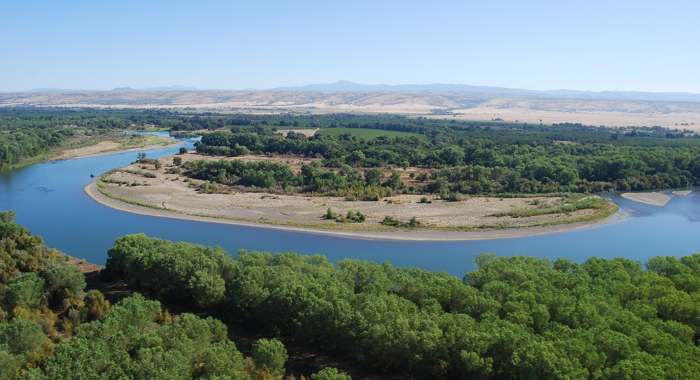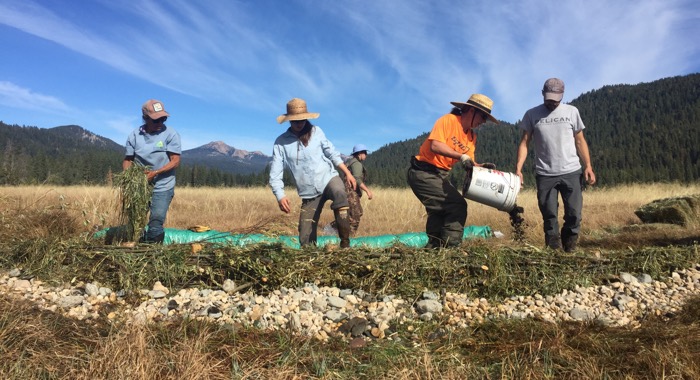Californians have fundamentally altered many of the state’s rivers and streams with dams, pipes, and diversions, and the State is home to some of the world’s most complex water delivery projects. As an unfortunate consequence, habitat for many freshwater species has been degraded or destroyed.
But, is it necessary to tradeoff the freshwater needs of birds, fish, and other species against the needs of farms and cities? Could freshwater flows be managed to better mimic the dynamics of their unimpaired past, dynamics to which native species have adapted and need to persist? And how should climate change considerations be incorporated into water management, to enhance the resilience of freshwater systems for both people and nature?
Our science is focused on tackling these questions.


Golet G.H., Kristen E. Dybala, Joeseph G. Silvera, Adam Henderson, Jennifer Isola, David H. Wright, Ron Melcer Jr., and Danika Tsao.
Lowland alluvial rivers are rich in biodiversity, yet many are highly degraded and no longer support robust natural communities. Over the past few decades, Bank Swallows, which depend upon these…Erin. E. Conlisk, Gregory H. Golet, Mark D. Reynolds, Nathan Elliot. and Matthew E. Reiter
Shorebirds are the second fastest declining group of birds in North America. To reverse this trend, The Nature Conservancy has been implementing BirdReturns, a habitat incentive program that pays…Michael J. Clifford, Sophie S. Parker, Laurel Saito, Brian S. Cohen, Naomi S. Fraga
Lithium batteries are important for the clean energy transition in the United States because they are used in electric vehicles and for grid power storage. However, lithium extraction may have impacts…Sophie S. Parker, Michael J. Clifford, Brian S. Cohen
To address climate change, the United States is incentivizing the production of electric vehicles containing domestically derived lithium batteries. Extracting this lithium may have environmental…Michael Clifford, Sophie Parker, Matt Rader, Lydia Bailey, Naomi Fraga, Chris Hass, Estella Hernandez, Jan Kempf, Lois Merkler, Michael Swink
The Amargosa River supports one of the most outstanding suites of endemic and imperiled species in the world. In 2019, TNC acquired the Atwood Preserve in the river’s headwaters, the…Kristen E. Dybala, Kristin. A. Sesser, Matthew E. Reiter, W. David Shuford, Gregory. H. Golet, Catherine Hickey, and Thomas Gardali
Conserving birds is a key goal for management of the Sacramento–San Joaquin Delta ecosystem, one of the largest estuaries on the Pacific Coast, and is likely to have effects for populations well…Kristina Kreter, Shona Ganguly, Rowan Roderick-Jones, and Kelsey Jessup
New strategies to address urban runoff management with nature-based approaches offer promising solutions to alleviating climate change impacts—like urban heat, water shortages, and…Julie Zimmerman, Jennifer Carah, Kirk Klausmeyer, Gabe Rossi, Mia Van Docto, Jeanette Howard, Charlie Schneider, Matt Clifford, Monty Schmitt
Drought conditions are occurring with more frequency, greater severity, and longer duration under climate change. Human water use compounds the effects of drought, further stressing California’s…Taylor-Burns, R., Heard, S., Beck, M. W.
There is growing evidence for the beneficial role that wetlands can play in reducing flood risk, but in many urban estuaries, coastal development has resulted in dramatic habitat loss and…Erin E. Conlisk, Kristin B. Byrd, Elliot Matchett, Austin A. Lorenz, Michael Casazza, Gregory H. Golet, Mark D. Reynolds, Kristin A. Sesser, and Matthew E. Reiter
Landscape-scale wetland conservation requires understanding how wildlife responds to dynamic freshwater habitat availability. This study examined this for dabbling ducks by comparing habitat…James W. Roche, Kristen N. Wilson, Qin Ma, Roger C. Bales
This study evaluated the water balance components of precipitation, evapotranspiration, discharge, and change in storage compared to measured streamflow and unregulated streamflow estimates in the…Sophie S. Parker, Linnea S. Hall, Mary J. Whitfield, Laura Riege, Kathryn R. Selm, René Corado
This paper presents results from a field-based study that can be used to benefit songbirds in riverside habitats like those found along the Santa Clara River in Ventura County, California. Songbirds…Eric D. Stein, Michael E. McClain, Ashmita Sengupta, Theodore E. Grantham, Julie K.H. Zimmerman, Sarah M. Yarnell
In this chapter of Water Resources Allocation and Agriculture, the authors provide insights on how to integrate environmental flows into water allocation for agriculture across the world. They argue…Sophie S. Parker, Bradley Franklin, Brian S. Cohen, Melissa M. Rohde, Michael Clifford, Andrew Williams
Climate change will cause severe financial, social, and environmental upheaval if a massive reduction in carbon emissions is not achieved by 2030. To address this challenge, rechargeable lithium-ion…Gregory. H. Golet, Kristen. E. Dybala, Matthew. E. Reiter, Kristin. A. Sesser, Mark Reynolds, Rodd Kelsey
Shorebirds have declined precipitously in North America in the last 50 years, primarily due to the loss of wetlands. Incentive programs that pay farmers to create temporary wetland habitat on idled…Roland Geyer, Jenna Gavigan, Alexis M. Jackson, Vienna R. Saccomanno, Sangwon Suh, Mary G. Gleason
Synthetic microfibers are the most prevalent type of microplastic and apparel washing is a major source of microfiber pollution. Using California as a case study to estimate the magnitude of…Gabriel Rossi, Darren Mierau, Jennifer Carah
A simple stream depth measurement at the deepest part of a riffle crest in a river or stream provides an easy-to-measure and inexpensive metric for ecological researech, environmental flow management,…Theodore E. Grantham, Daren M. Carlisle, Jeanette Howard, Belize Lane, Robert Lusardi, Alyssa Obester, Samuel Sandoval-Solis, Bronwen Stanford, Eric D. Stein, Kristine T. Taniguchi-Quan, Sarah M. Yarnell, Julie K. H. Zimmerman
Protecting water in rivers is made more challenging by the lack of quantitative estimates of the amount of water required to protect river ecosystems. The authors developed a model and made…Sarah M. Yarnell, Ann Willis, Alyssa Obester, Ryan A. Peek, Robert A. Lusardi, Julie Zimmerman, Theodore E. Grantham, Eric D. Stein
Very few rivers have protections to protect flow for species and ecosystems, in part because of the complexity and resources required to develop ecological flow criteria - the amount of water needed…